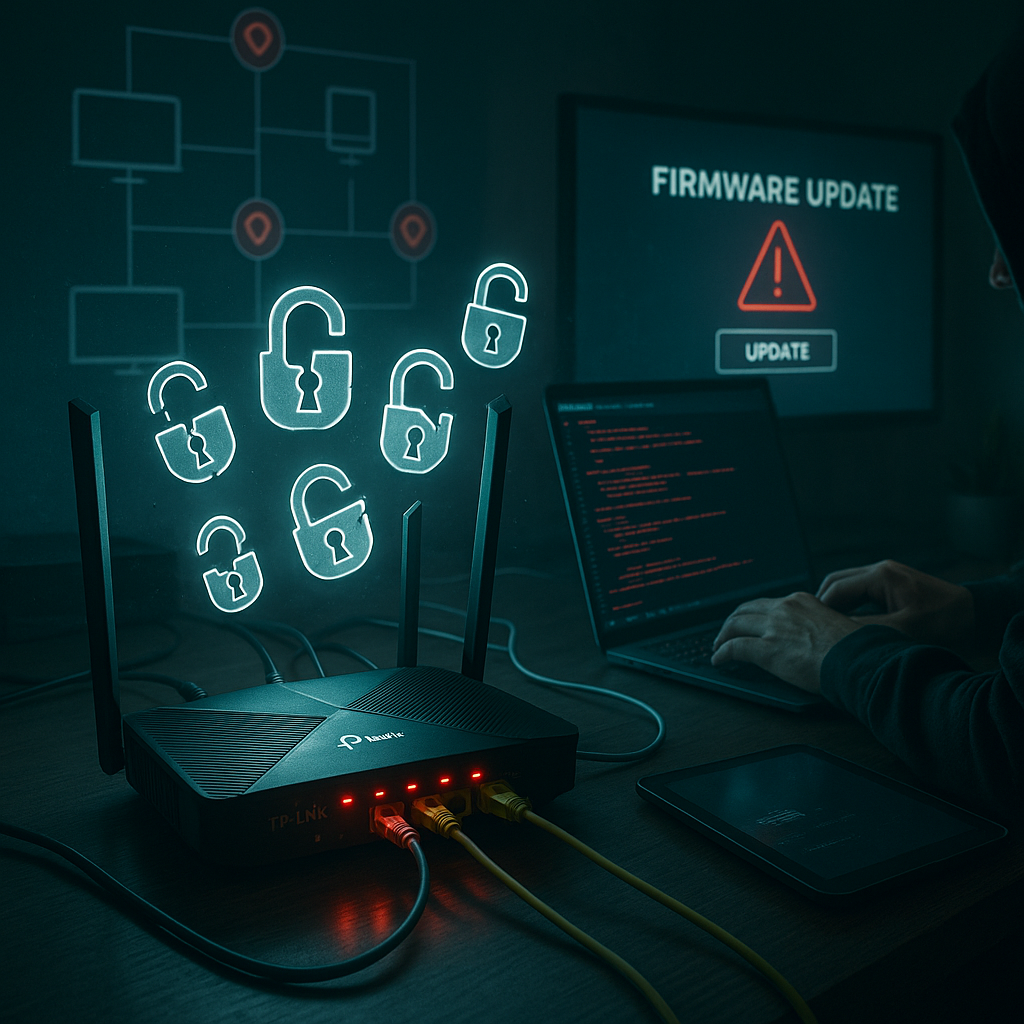Key Takeaways
- Critical vulnerabilities found: Cybersecurity experts identified multiple security flaws in select TP-Link router models, enabling attackers to gain root-level control.
- Affected models widely used: The vulnerabilities impact several mainstream consumer and small business routers, increasing the number of users at risk.
- Potential for remote exploits: Exploits can be carried out over the internet, not just locally, making unpatched devices vulnerable even without physical access.
- TP-Link releases security advisories: The company has acknowledged the flaws and is urging customers to install firmware updates as soon as they become available.
- Next steps for users: Users should check for official TP-Link firmware updates immediately. Those with vulnerable routers are advised to update as soon as possible to prevent compromise.
Introduction
Multiple critical security vulnerabilities have been discovered in several popular TP-Link routers, according to researchers this week. These flaws allow attackers to gain full root access and potentially take control of affected devices remotely. With many mainstream consumer and business models at risk, TP-Link advises all users to check for and install official firmware updates promptly to protect against data theft and network compromise.
What Security Flaws Were Discovered
Security researchers have identified multiple critical vulnerabilities in several TP-Link router models that could grant attackers complete control over these devices. The most severe flaw allows malicious actors to bypass authentication safeguards and obtain root access.
Root access provides the highest level of control over a device, giving attackers administrative privileges similar to the manufacturer. With this control, they could intercept internet traffic, steal sensitive information, or use compromised routers to attack other connected devices.
Researchers from cybersecurity firm BitDefender discovered these vulnerabilities during a routine security audit of popular consumer networking equipment. The team found that certain TP-Link firmware versions contain programming errors that attackers can exploit to run malicious code and commands.
Un passo avanti. Sempre.
Unisciti al nostro canale Telegram per ricevere
aggiornamenti mirati, notizie selezionate e contenuti che fanno davvero la differenza.
Zero distrazioni, solo ciò che conta.
 Entra nel Canale
Entra nel Canale
Which TP-Link Routers Are Affected
The security flaws affect several widely-used TP-Link router models, including:
- Archer AX50
- Archer AX10
- Archer C7 (versions 5 and 6)
- Archer A7
- Deco X20
- Deco M4
- Several models in the Omada business series
These models are among TP-Link’s most popular consumer and small business routers, with an estimated 15–20 million units in use worldwide. TP-Link holds a significant market share in the consumer router segment, particularly in North America and Europe.
The vulnerabilities affect both older and some recently released models, suggesting these security issues have persisted across multiple product generations. Routers running firmware versions released before April 2023 are most likely to be vulnerable.
How the Vulnerabilities Work
The primary vulnerability exists in the router’s web-based administration interface, where a flaw in the authentication mechanism enables attackers to bypass login credentials entirely. This vulnerability, tracked as CVE-2023-1389, does not require special tools or advanced skills to exploit.
The authentication bypass is particularly concerning because it can potentially be exploited remotely if the router’s remote management feature is enabled, according to James Forshaw, a security researcher at Google’s Project Zero who independently verified the findings.
Attackers connected to the same Wi-Fi network can also exploit a command injection vulnerability (CVE-2023-1390) to execute arbitrary commands with root privileges. This can occur through malicious websites or compromised devices already on the network.
For some models, researchers found an additional vulnerability in the router’s UPnP (Universal Plug and Play) implementation. This issue could allow remote exploitation even if remote management is disabled, as attackers can trigger it by sending specially crafted packets to the router from any location on the internet.
TP-Link’s Response
TP-Link acknowledged the vulnerabilities on Tuesday and issued a security advisory on its website. The company stated that it takes these security issues very seriously and is working diligently to address them.
Firmware updates have been released for most affected models, with patches for remaining devices expected in the coming weeks. TP-Link has prioritized updates for the most recent and widely used models.
A TP-Link spokesperson stated that the security team worked closely with researchers to understand the scope of these vulnerabilities and to develop comprehensive fixes. Customers are encouraged to update their router firmware as soon as possible.
TP-Link has also established a dedicated security incident page where users can check if their specific model is affected and download the appropriate firmware update. The company indicated that newer production runs of these router models will ship with updated firmware already installed.
Steps to Secure Your Router
Users with affected TP-Link routers should take immediate action to secure their devices:
- Check if your router model is affected by visiting TP-Link’s security advisory page or comparing your model number to the list of affected devices.
- Update your router’s firmware by logging into the web administration interface. Typically, this involves typing “
192.168.0.1” or “192.168.1.1” in your web browser, entering your admin credentials, and navigating to the firmware update section. - If automatic updates are available, enable them to receive future security patches promptly.
- Disable remote management features unless absolutely necessary. This option is typically found in the “Advanced Settings” section of your router’s administration panel.
- Change your router’s admin password to a strong, unique passphrase that combines letters, numbers, and special characters.
- Ensure your Wi-Fi network uses WPA3 encryption if supported, or at minimum WPA2, and set a strong, unique password for your wireless network.
These steps will significantly reduce the risk of exploitation and help protect your home or business network from attacks targeting these vulnerabilities.
For broader online safety, adopting daily cyber hygiene habits such as regular updates, strong passwords, and multi-factor authentication is highly recommended.
Expert Recommendations
Cybersecurity professionals emphasize that router security should be a priority for all internet users, not only those affected by this incident. Katie Moussouris, founder of Luta Security, explained that a compromised router gives attackers visibility into all online activities.
Experts recommend broader protective measures beyond addressing these specific vulnerabilities. Setting up automatic firmware updates helps ensure timely receipt of security patches. Many modern routers support this feature, but it may require manual activation.
Un passo avanti. Sempre.
Unisciti al nostro canale Telegram per ricevere
aggiornamenti mirati, notizie selezionate e contenuti che fanno davvero la differenza.
Zero distrazioni, solo ciò che conta.
 Entra nel Canale
Entra nel Canale
Chris Krebs, former director of the Cybersecurity and Infrastructure Security Agency, advised implementing network segmentation by creating guest networks for visitors and separate networks for IoT devices to limit potential damage if one device is compromised.
Security professionals also suggest monitoring for unusual devices connected to your network and staying alert for unexpected performance changes, as these may signal compromise. Advanced users may utilize tools like Wireshark to analyze network traffic for suspicious activity.
Bruce Schneier, security technologist and author, noted that these vulnerabilities highlight why router security deserves more attention. Unlike computers and phones, which often prompt for updates, routers may run outdated software for years, creating ongoing security gaps.
If you’re concerned about your connected devices, check out smart home security tips for remote workers to tighten your defenses even further.
Conclusion
The discovery of critical flaws in widely used TP-Link routers underscores ongoing challenges in securing everyday internet devices from sophisticated attacks. As manufacturers distribute patches and users implement recommended safeguards, this incident highlights the importance of routine updates and strong network practices. What to watch: TP-Link’s continued rollout of firmware fixes and updates to its security advisory page in the coming weeks.
To further protect your devices, also consider reading about the importance of password managers as a key layer in your overall digital defense.





Leave a Reply